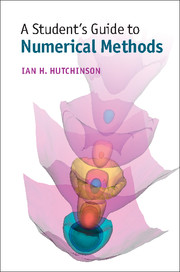Book contents
- Frontmatter
- Dedication
- Contents
- Preface
- 1 Fitting functions to data
- 2 Ordinary differential equations
- 3 Two-point boundary conditions
- 4 Partial differential equations
- 5 Diffusion. Parabolic partial differential equations
- 6 Elliptic problems and iterative matrix solution
- 7 Fluid dynamics and hyperbolic equations
- 8 Boltzmann's equation and its solution
- 9 Energy-resolved diffusive transport
- 10 Atomistic and particle-in-cell simulation
- 11 Monte Carlo techniques
- 12 Monte Carlo radiation transport
- 13 Next steps
- Appendix A Summary of matrix algebra
- References
- Index
11 - Monte Carlo techniques
Published online by Cambridge University Press: 05 May 2015
- Frontmatter
- Dedication
- Contents
- Preface
- 1 Fitting functions to data
- 2 Ordinary differential equations
- 3 Two-point boundary conditions
- 4 Partial differential equations
- 5 Diffusion. Parabolic partial differential equations
- 6 Elliptic problems and iterative matrix solution
- 7 Fluid dynamics and hyperbolic equations
- 8 Boltzmann's equation and its solution
- 9 Energy-resolved diffusive transport
- 10 Atomistic and particle-in-cell simulation
- 11 Monte Carlo techniques
- 12 Monte Carlo radiation transport
- 13 Next steps
- Appendix A Summary of matrix algebra
- References
- Index
Summary
So far we have been focussing on how particle codes work once the particles are launched. We've talked about how they are moved, and how self-consistent forces on them are calculated. What we have not addressed is how they are launched in an appropriate way in the first place, and how particles are reinjected into a simulation. We've also not explained how one decides statistically whether a collision has taken place to any particle and how one would then decide what scattering angle the collision corresponds to. All of this must be determined in computational physics and engineering by the use of random numbers and statistical distributions. Techniques based on random numbers are called by the name of the famous casino at Monte Carlo.
Probability and statistics
11.1.1 Probability and probability distribution
Probability, in the mathematically precise sense, is an idealization of the repetition of a measurement, or a sample, or some other test. The result in each individual case is supposed to be unpredictable to some extent, but the repeated tests show some average trends that it is the job of probability to represent. So, for example, the single toss of a coin gives an unpredictable result: heads or tails; but the repeated toss of a (fair) coin gives on average equal numbers of heads and tails. Probability theory describes that regularity by saying the probability of heads and tails is equal. Generally, the probability of a particular class of outcomes (e.g. heads) is defined as the fraction of the outcomes, in a very large number of tests, that are in the particular class. For a fair coin toss, the probability of heads is the fraction of outcomes of a large number of tosses that is heads, 0.5. For a six-sided die, the probability of getting any particular value, say 1, is the fraction of rolls that come up 1, in a very large number of tests.
- Type
- Chapter
- Information
- A Student's Guide to Numerical Methods , pp. 144 - 157Publisher: Cambridge University PressPrint publication year: 2015



